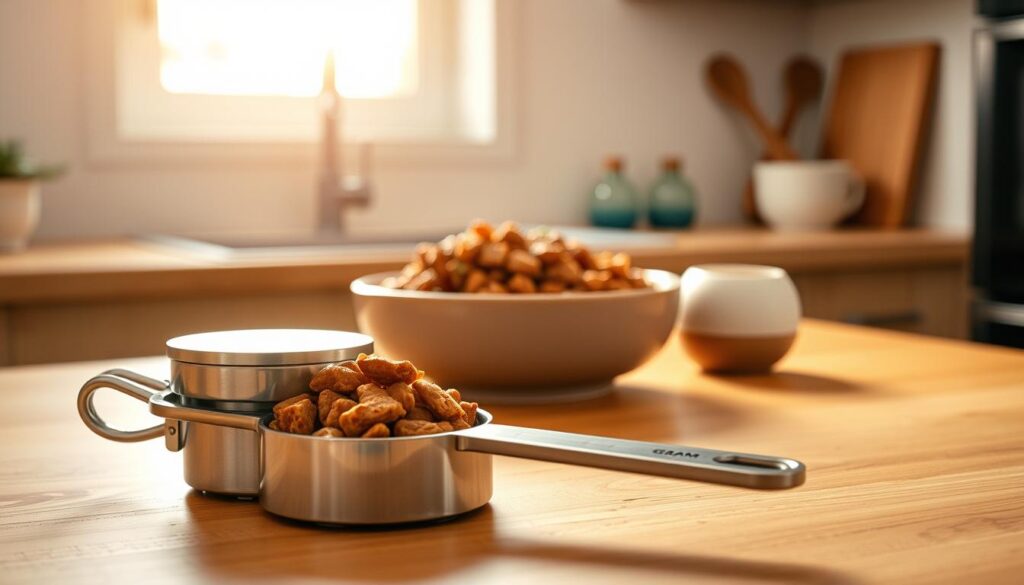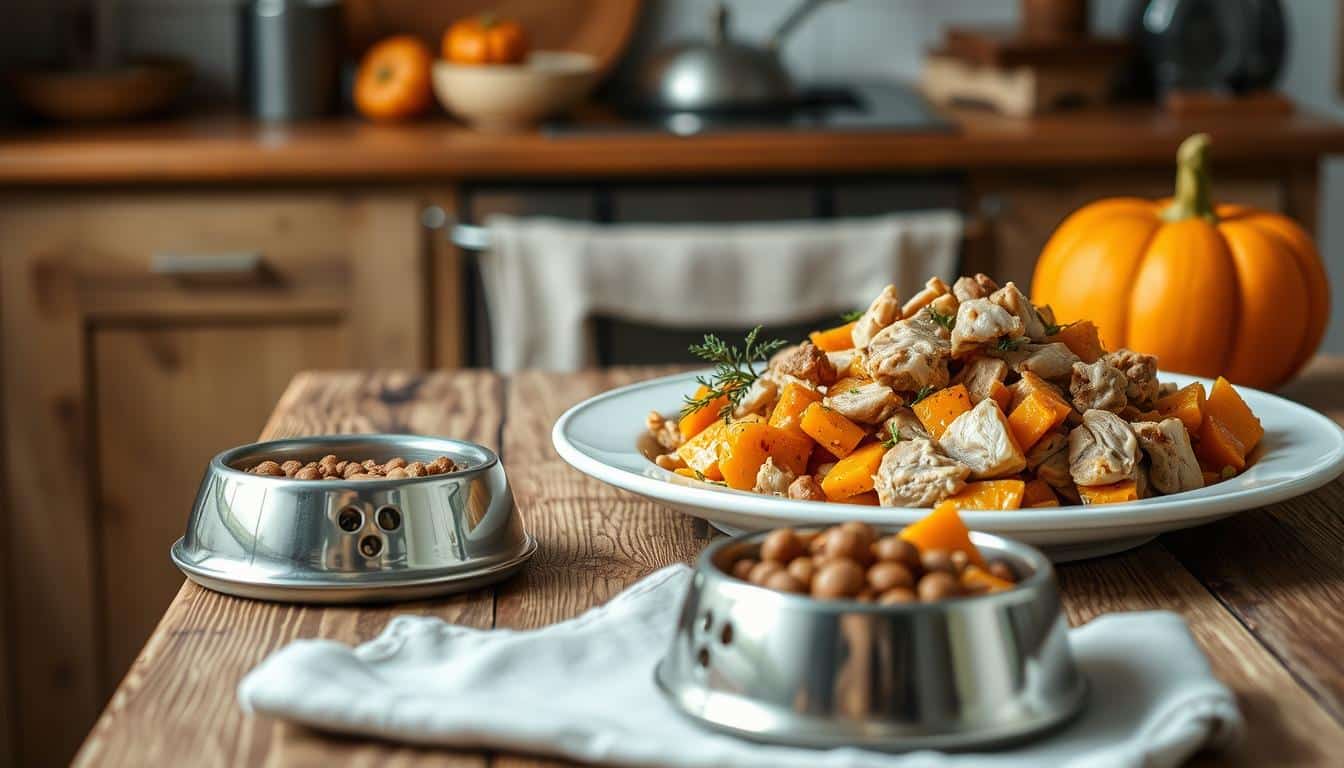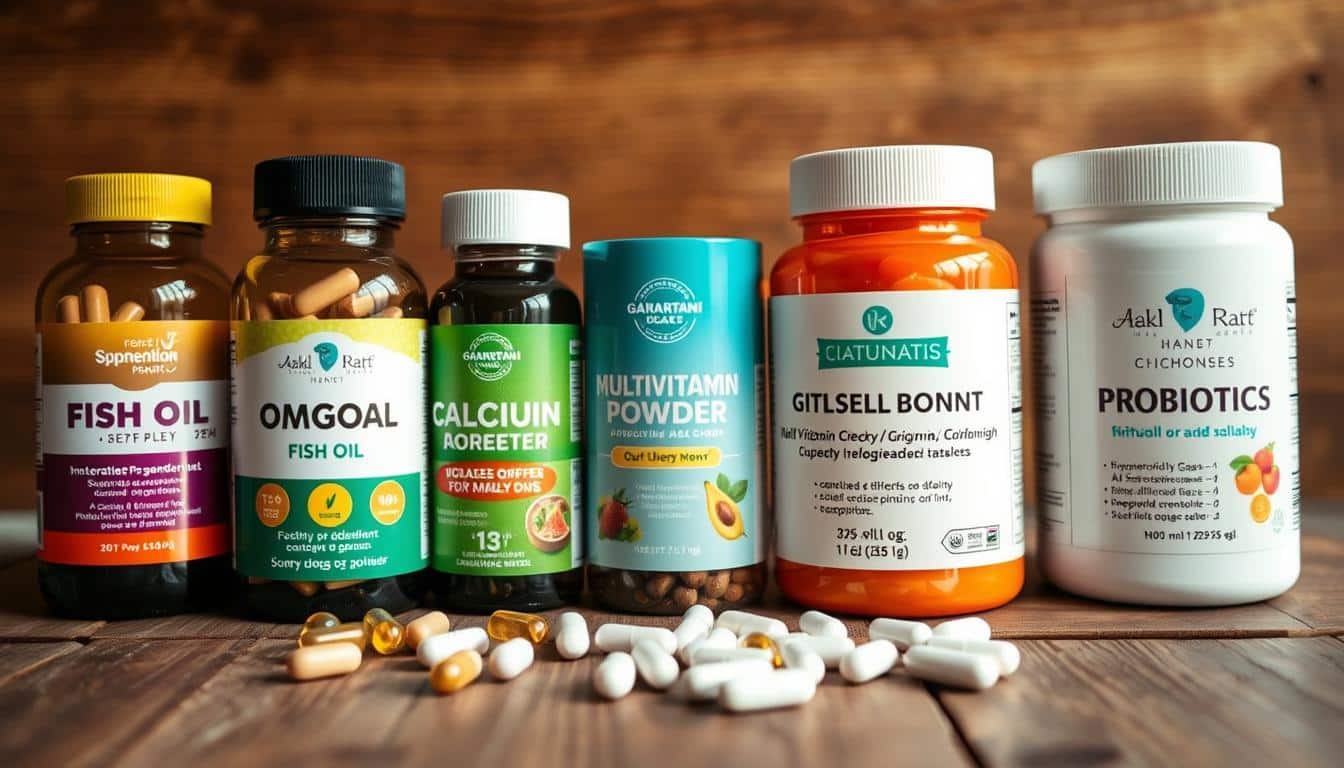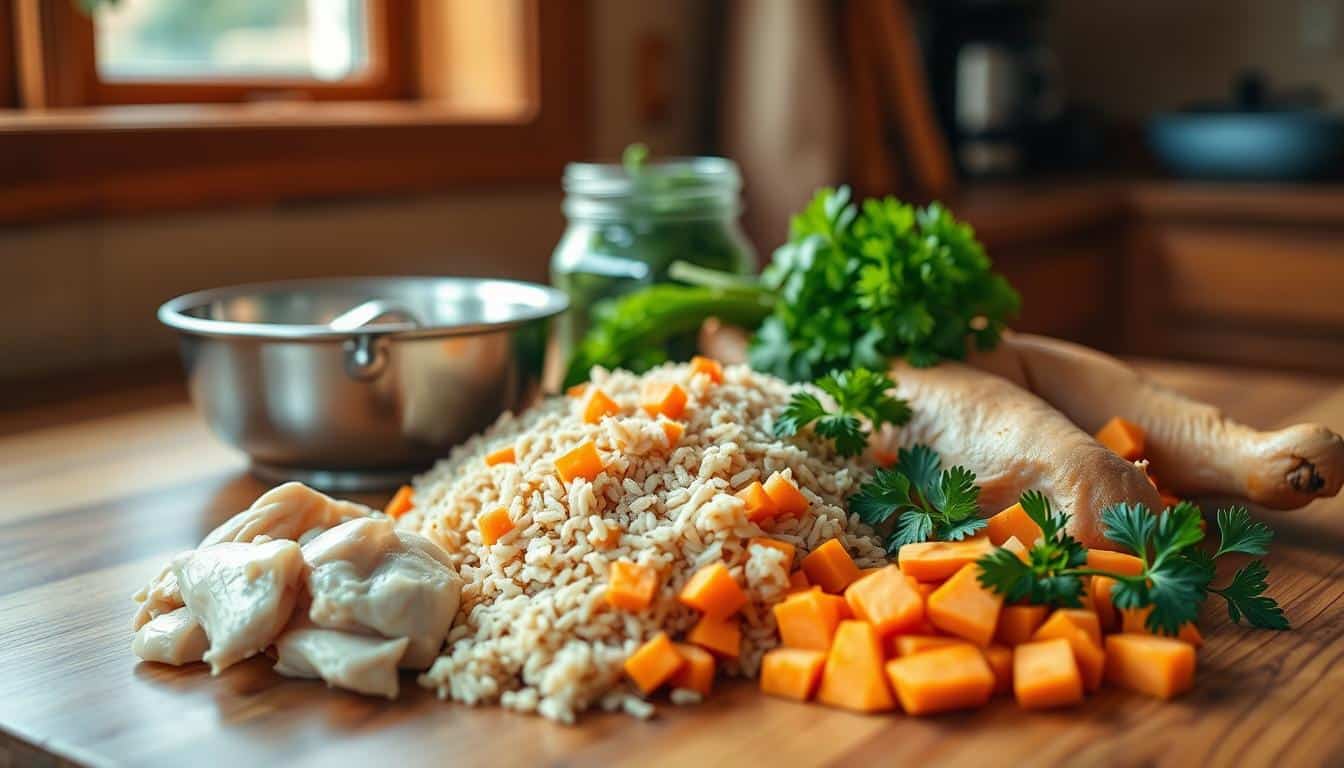More pet owners in the United States are now cooking for their dogs. They do this to know exactly what’s in their pet’s food, handle food allergies, and bond with their furry friends. A homemade diet for small breeds can offer clear benefits, like knowing what’s in the food, making meals that picky eaters will love, and creating special dishes for dogs with food allergies.
But, this approach has its downsides. Making homemade food wrong can hurt small dogs through unbalanced meals, missing important nutrients, or giving them the wrong amount of food. Small dogs have different nutritional needs than larger dogs. What seems healthy may not be enough for a tiny dog.
The key advice is straightforward: don’t just make it up. Prevent mistakes with homemade dog food by using tried-and-true recipes or tools like BalanceIT or Animal Diet Formulator. For those with greater risks, it’s wise to talk to a vet nutritionist before changing your dog’s diet for good.
To avoid issues, follow advice from vet experts. Weigh ingredients after cooking for precise measures, prepare meals in batches and freeze them, blend food to prevent picky eating, and see the vet for check-ups and tests every six months. This helps find any nutritional shortages early on.
Why small breeds have unique nutritional needs
Small dogs are more than just mini versions of big dogs. They use energy in a different way, grow quickly, and have their own health issues. This means feeding them the right way is crucial. Owners need to think about how much energy toy dogs use, control how much they eat, and what they eat at each stage of their life. This helps keep a small dog healthy for a long time.
Metabolic rate and portion sizing differences
Small breeds use up calories much quicker per pound. This means their food needs to be packed with calories to meet their energy needs without feeding them too much. If a tiny puppy, like a Chihuahua, doesn’t eat often enough, it could have low blood sugar levels.
It’s important to measure toy dogs’ food carefully. Guessing can lead to giving them too much or too little food. Instead of using scoops or cups, measuring food in cooked grams and watching their body condition is better.
Growth, longevity, and breed-specific health risks
Small breeds often live longer than bigger dogs. This means what they eat early on is very important. Eating the wrong food for a long time can lead to health problems like bad teeth, knee issues, or problems with their metabolism.
Their growth needs special attention. Puppies of toy breeds need the right balance to avoid issues with their growth plates. Getting the right nutrients early on helps them reach the right adult size and keeps their joints healthy.
How small size changes nutrient ratios and feeding frequency
Being small means they need different amounts of nutrients. They need more of certain vitamins and minerals per kilogram. But, minerals like calcium and phosphorus need to be just right to make sure their bones grow properly. Not getting the balance right can affect small dogs more than big dogs.
Toy breeds do better with several small meals a day. They can’t hold a lot in their stomach and use up glucose quickly. So, feeding them three or four times a day works best for many. Remember to adjust how much and how often they eat based on their age, how active they are, and whether they’ve been spayed or neutered.
- Measure portions by cooked grams for accuracy.
- Base calorie targets on metabolic rate, not breed myth.
- Review nutrient ratios small dogs need during puppy, adult, and senior stages.
- Set feeding frequency toy breeds tolerate to avoid hypoglycemia and weight swings.
Common homemade food mistakes that harm small breeds
Many people with small dogs try making food at home to offer better meals. However, simple mistakes can lead to big nutritional risks. These can impact a dog’s growth, coat, digestion, and overall health.
Feeding only muscle meat and skipping organs
It’s common to just use muscle meat in homemade dog food. This approach misses out on essential vitamins and minerals found in organs. Without organs, dogs can lack vitamin A, copper, and B vitamins, which muscle meat can’t provide.
Inadequate micronutrients: calcium, iodine, selenium, vitamins D and E
Bones and minerals are key for healthy teeth and bones. Skipping them can lead to a calcium deficiency, especially in small breeds. Low levels of iodine or selenium can affect the thyroid, and missing vitamins D and E hurt immunity and cellular health. Over time, these gaps can cause lasting damage.
Wrong fat balance for small-breed skin, coat, and inflammation control
Homemade diets sometimes use fats that aren’t ideal, raising omega-6 levels. This imbalance increases inflammation and can make a dog’s skin dry and flaky. Use things like marine oils, flax, or canola oil to help support a healthy coat and reduce inflammation.
Insufficient fiber and its effect on digestion and microbiome
Not including enough fiber can hurt a dog’s gut health and stool quality. Good fiber sources include low-starch vegetables, canned pumpkin, and fruits like blueberries. These help feed good bacteria, add antioxidants, and manage blood sugar and digestion.
- Rotate organ sources like liver and kidney to prevent both excess and deficiency.
- Use tested calcium supplements or finely ground bone to correct mineral gaps.
- Balance oils to approach a 2:1–5:1 omega-3 omega-6 ratio dogs need for reduced inflammation.
- Add measured fiber servings daily to promote a healthy microbiome and regular stools.
Sticking only to random recipes can lead to nutritional mistakes. Making thoughtful additions and regular checks can avoid common issues related to homemade dog food.
Risks of unbalanced homemade recipes for small dogs
Small dogs on homemade diets might slowly run into trouble. These issues often stem from not getting the right nutrients. They impact the dog’s immunity, skin health, digestion, and how organs work. Regular vet visits and specific blood tests can find problems early on.
Consequences of chronic deficiencies and excesses
Not getting enough vitamins and minerals, or getting too much, leads to visible health problems. This can make the immune system weak and slow down healing. Signs include a bad coat, frequent skin infections, and upset stomach.
Having too many nutrients is also bad. Too much vitamin A or calcium, for example, can harm bones and kidneys. Vets often find odd test results in pets eating homemade meals that vary a lot.
Bone growth, dental health, and mineral imbalances in toy breeds
Toy breeds face big dangers if their food has the wrong calcium to phosphorus ratio. This can cause bone and dental issues. It’s crucial during their growing phase.
Too much or too little calcium can both be harmful, depending on the pup’s age. It’s best to steer clear of homemade food that doesn’t measure minerals carefully.
Examples of conditions linked to poor homemade diets
Poor homemade diets in dogs can lead to weight loss and muscle loss. They can also cause conditions due to missing vitamins, like rickets or neurologic issues. Some worry that taurine shortage or trendy grain-free diets might link to heart problems in certain dogs.
- Protein and amino-acid gaps that affect heart and muscle health.
- Micronutrient deficits such as vitamin D or selenium triggering systemic illness.
- Fatty-acid imbalance worsening chronic inflammation and skin disease.
Vets and nutrition experts often see sick pets from bad homemade food. Catching these issues through regular checks can save a pet from serious harm.
How to use supplements correctly to balance homemade meals
Making balanced homemade meals requires careful choices. Some supplements are needed to meet basic nutrient needs. They help make sure your homemade diet is complete. It’s smart to pair lab tests with reliable tools and expert advice.
Dogs often need certain supplements like calcium or a product to replace bone. They also need a mix that includes iodine, selenium, and vitamins D and E. This mix should have trace minerals like zinc and manganese. For diets low in organ meat or high in certain grains, taurine or carnitine might be necessary. There are also optional supplements for joint health, digestion, or immune support.
Typical vitamin/mineral mixes and when they’re necessary
- Use a full mix if the diet lacks organs, seafood, or enriched ingredients.
- Opt for products made by vets for consistent dosing and quality.
- Always base dosing on thorough nutrition tests, not just any recipe.
Working with veterinary nutritionists and trusted formulation tools
Getting help from a pro lowers risks. A board-certified vet nutritionist can look at lab results. They can say if supplements are needed and how much to use. Many dog owners turn to BalanceIT or Animal Diet Formulator for help making balanced meals. BalanceIT has vet experts to check the recipes. Animal Diet Formulator lets you adjust nutrients to fit your dog’s needs.
Work with your vet and a nutritionist when picking supplements. Regular tests can show if the supplements are working without causing harm.
Choose supplements with clear labels and that have been tested. Keep track of what you use and the test results. This makes changing the diet safer and keeps your small dog healthy on a homemade diet.
Safe ingredient choices and dangerous human foods for small breeds
Homemade feeding is great for small dogs if you pick the right ingredients. They should help with digestion, skin, and the heart. Keep fruits and veggies less than 25% of the meal. Go for foods rich in soluble fiber, antioxidants, and healthy fats.
- Dog-safe foods to add sparingly:
- Green beans, cooked squash, and steamed spinach give low-glycemic fiber.
- Puréed blueberries or mashed apple (no seeds) offer antioxidants.
- Cooked eggs provide easily used protein and choline.
- Cooked salmon, sardines, or a tested fish oil product supply EPA/DHA.
- Pumpkin or psyllium adds soluble fiber to help with bowel movements and gut health.
For toy breeds, keep the added portions small. Mix them into a base diet of muscle meat and organs. Or, use them with a vet-recommended supplement. If your dog needs more omega-3, choose whole fish or trusted supplements. Brands like Nordic Naturals or Zesty Paws are good, but check with your vet first.
- Dangerous human foods dogs that must be avoided:
- Xylitol, in sugar-free gum and treats, can lead to sudden low blood sugar and liver issues. Know the signs of xylitol poisoning and act quickly.
- Avoid chocolate, grapes, raisins, onions, garlic, macadamia nuts, and avocado. They can cause serious problems.
- Keep table scraps away from small breeds. Tell your guests and family about the risks.
Be careful with legumes or peas as grain substitutes. Some experts link them to heart issues in dogs eating grain-free foods. The problem isn’t fully understood yet. But try to avoid a diet heavy in legumes. Make sure a professional checks the diet for necessary nutrients.
Before giving any human food or ingredient to your dog, check if it’s safe. Call the Pet Poison Helpline or your vet if you’re not sure. With small breeds, it’s really important to watch what they eat to keep them healthy.
Practical recipe and preparation tips to avoid mistakes
Making meals at home requires careful planning and technique. Tiny adjustments in cooking and serving sizes can make a big difference in nutrition. Here are some tips for preparing food for small dogs.

Measure by weight. It’s better to use a digital scale to measure dog food. This ensures you give the right amount of proteins, grains, and veggies. It helps prevent giving too much fat or not enough protein and minerals.
-
Weigh ingredients after they’re cooked, because they lose water and change size.
-
Keep track of cooked gram weights for each recipe to ensure consistent portions.
Batch prep with care. Preparing dog food in batches saves time and keeps meals the same. Make many servings at once, divide them into meal-size containers, and either freeze or chill them with clear labels.
-
Write down the date and what’s in each portion on the label.
-
Keep cooked food in the fridge for up to 5 days; freeze it if you want to store it longer.
-
Use the oldest frozen meals first to avoid losing nutrients.
Control browning and heat. Use gentle cooking methods to avoid changing essential nutrients. Cooking at high temperatures can make it harder for dogs to digest food.
-
When you can, poach proteins to keep the nutrients intact.
-
Try not to grill or roast too often if the meal is a regular part of your dog’s diet.
Make textures uniform. Grinding or blending dog food helps avoid picky eating. When the meal is mixed well, dogs are less likely to leave behind important nutrients found in organs or vegetables.
-
Chop meats and veggies finely so they’re easier for small dogs to eat.
-
Blended food is easier to digest, helping small dogs get more nutrition.
Follow validated recipes. Use recipes from certified veterinary nutritionists or reputable sources. Stick with proven ratios of ingredients and don’t substitute without expert advice.
Label and track. Clearly mark freezer meals with the date and what’s inside. Maintain a system to use meals in the right order. This keeps the nutrient content consistent and homemade dog food reliable.
Portion control, weight management, and feeding schedules for petite pups
Small dogs need special feeding plans to keep fit. It’s best to use a kitchen scale and set calorie goals. This depends on their weight, age, and how active they are. To stop them from getting too heavy, measure their food accurately.
Weigh every ingredient before you cook. Add up the cooked food’s weight for each meal. Keep treats to less than 10% of their daily calories. For training, cut treats into small pieces. This keeps their diet balanced.
Adjusting by life stage
Puppies eat little and often. Grown dogs do well with two or three meals a day. Older dogs might need different amounts or feeding times. It’s important to fit the food routine to your dog’s energy and growth.
Monitoring body condition and labs
Look over your dog’s weight and shape every month. Small changes are easier to manage if caught early. Pair these home checks with regular vet visits. Pets fed homemade diets should have blood tests twice a year.
- Set calorie targets with your veterinarian or a credentialed nutritionist.
- Use measured meals and timed feedings to prevent grazing and begging.
- Adjust portions when body condition score dogs move out of the ideal range.
- Order blood and urine panels if weight or energy levels change unexpectedly.
Always work with a vet you trust when choosing food or changing recipes, especially if tests or weight changes suggest it. Accurate measurements, correct feeding times, and steady check-ups help keep your dog healthy for a long time.
When to consult a veterinary nutritionist or choose commercial alternatives
Homemade dog meals are made with love, but they can sometimes miss the mark. If your dog starts losing or gaining weight unexpectedly, has a dull coat, experiences chronic diarrhea, shows abnormal bloodwork results, grows slowly as a puppy, or has heart issues, it’s time for professional help. Feeding your dog the same unverified recipe for too long can lead to problems that regular check-ups might not find.
Wondering whether to continue cooking for your dog or switch to commercial dog food? Use this list to help decide.
- Weight trends that do not respond to portion adjustments.
- Poor skin or coat despite correct parasite control and flea prevention.
- Recurring gastrointestinal upset or food aversion.
- Abnormal lab values on CBC, chemistry, or thyroid testing.
- Growth plate or dental issues in toy-breed puppies.
Look closely at dog food labels before buying. Find an AAFCO nutritional adequacy statement and a guaranteed analysis. Check the ingredients and ensure the maker gives detailed nutrition facts. Picking brands that show lab-verified nutrition details or do feeding trials can lower risks for small dogs.
Choose commercial whole-foods for your dog if you prefer ingredients you recognize without the hassle. Pre-made foods from trusted companies give balanced nutrition and the right portion sizes for your dog.
Talk to your vet and a nutritionist if your pet needs a special diet. For problems like allergies, joint disease, or heart issues, your vet might suggest specific diets or supplements. Always use tests like blood work and urine analysis to pick the right supplements and doses instead of just guessing.
- Have a board-certified nutritionist check any homemade recipe or BalanceIT/Animal Diet Formulator output before using it long-term.
- Ask your vet to help read lab tests and choose the right special diet for your pet’s health issue.
- Regularly check your pet’s weight, coat, and lab results to make sure your food choice is effective.
Working together, your vet and a nutritionist can make a safe, custom feeding plan. This teamwork minimizes risk and ensures small breed dogs do well on either homemade or commercial dog foods.
Conclusion
Making dog food at home lets you use fresh ingredients and have control. But, it comes with risks if the diet isn’t complete. It’s important to get the right mix of organs, fiber, micronutrients, and fats for small dogs. Avoid mistakes by using recipes that have been checked and approved.
Use reliable tools like BalanceIT or Animal Diet Formulator for making food. Include organ meats and whole foods for nutrients. Strive for a balance of omega-6 and omega-3 fats near 2:1. Also, remember to add needed supplements.
Weigh the food after cooking and prepare in batches to keep mistakes low. Avoid cooking at high temperatures to prevent destroying important fats and vitamins. This helps make sure your homemade dog food is well-balanced.
Keep an eye on your dog’s weight and health, and test blood and urine twice a year. If you notice health issues or have doubts, talk to a vet who knows about dog diets. If making food at home is too hard, look at commercial foods that are complete and meet AAFCO standards.
Never just guess when making dog food at home. Planning, getting advice from experts, and watching your dog closely are key to avoid diet mistakes. Focus on nutrition safety for small breeds to ensure they live long, healthy lives.
FAQ
What makes small breeds’ nutritional needs different from larger dogs?
Why do pet parents choose homemade food for small dogs?
What are the most common homemade-food mistakes that harm small breeds?
Why is feeding only muscle meat dangerous?
How important is calcium and phosphorus balance for toy-breed puppies?
What fat balance should I aim for in homemade small‑dog diets?
How does low fiber affect a small dog fed homemade food?
Are grain‑free or legume‑heavy homemade recipes safe?
What supplements are required when feeding homemade meals?
What supplements are optional or condition‑specific?
Which formulation tools and services are trusted for balancing recipes?
How should I measure and portion homemade food for a small dog?
How often should I feed a small breed on homemade diets?
What preparation techniques reduce nutrient damage and prevent selective eating?
Which human foods are safe additions and which are toxic?
How do I guard against Maillard reaction damage when cooking?
How often should homemade‑fed dogs have veterinary exams and lab testing?
What signs mean my dog’s homemade diet needs professional review?
Can I rely on several different homemade recipes to cover nutrient gaps?
What should I look for in commercial whole‑food or ready‑made options?
How do I correct omega‑6:omega‑3 imbalance in a chicken‑heavy homemade diet?
How should treats fit into a homemade feeding plan?
Are there situations where I should choose commercial therapeutic diets instead of homemade food?
How can I ensure my homemade recipe meets micronutrient needs?
What role do iodine and selenium play in small‑dog nutrition?
How can I prevent selective eating when serving mixed homemade meals?
What are the clinical consequences of long‑term poorly balanced homemade feeding?
How do I label, store, and preserve homemade meals safely?
Can I swap ingredients in a validated recipe?
What routine monitoring should owners do at home?
Where can I get immediate help for suspected toxic human food ingestion?
What is the single most important takeaway for feeding small breeds homemade food?
Content created with the help of Artificial Intelligence.



